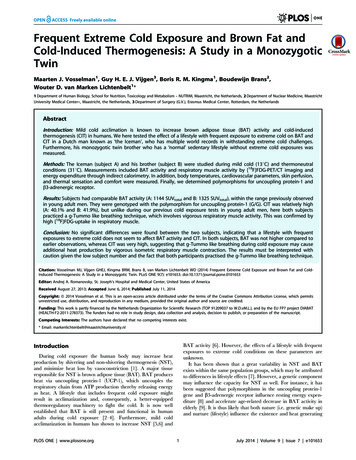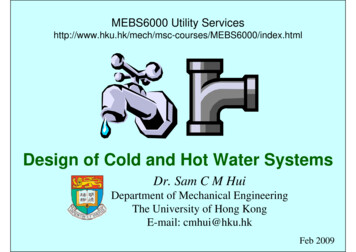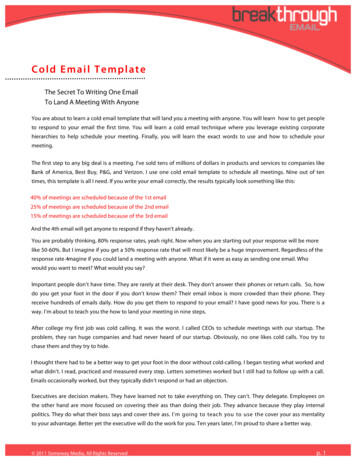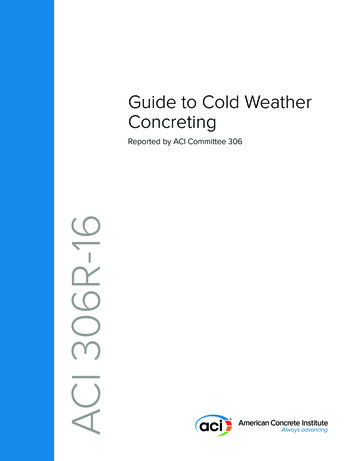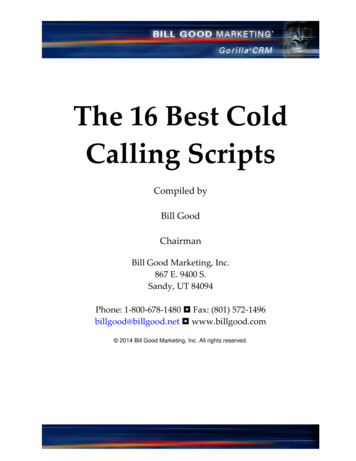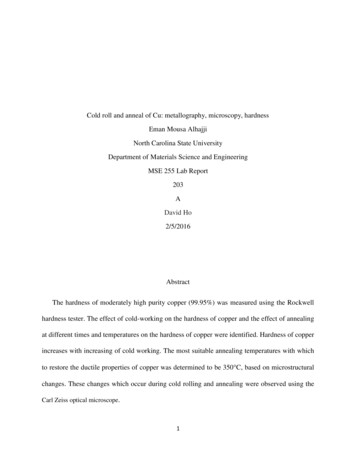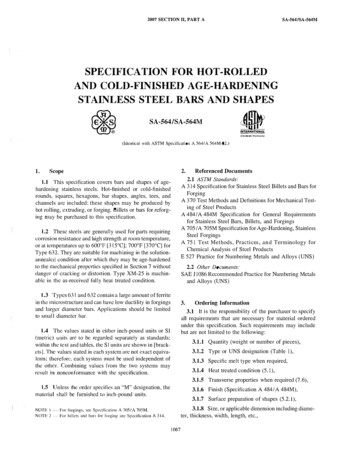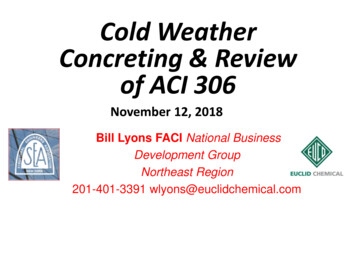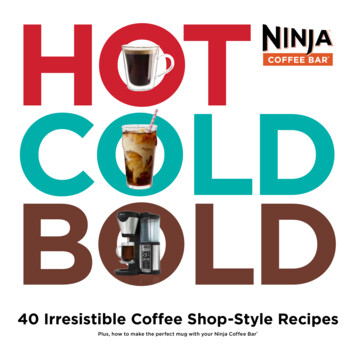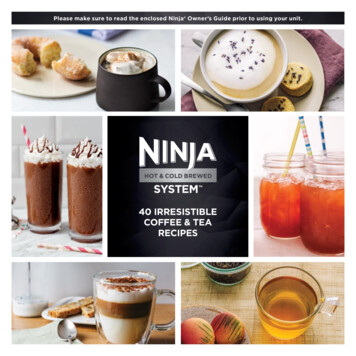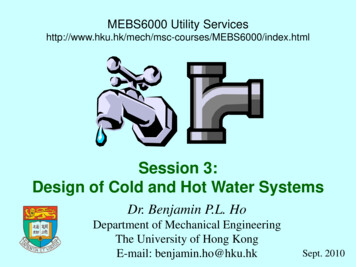
Transcription
MEBS6000 Utility 0/index.htmlSession 3:Design of Cold and Hot Water SystemsDr. Benjamin P.L. HoDepartment of Mechanical EngineeringThe University of Hong KongE-mail: benjamin.ho@hku.hkSept. 2010
Contents for this session Design principlesWater demandWater storagePipe sizingPipe materialsPump systemsOther considerations2
Design principles Common water supply systems Cold water system Potable water Flushing water (fresh or salt water) Non-potable water Cleansing waterFire serviceSwimming pool filtrationIrrigation (e.g. for landscape)Fountain circulationAir-conditioning water, etc. Hot water system (e.g. in hotels & hospitals)3
Design principles Major tasks of water systems design: 1. Assessment & estimation of demands2. Supply scheme & schematic3. Water storage requirements4. Piping layout5. Pipe sizing6. Pump system design The systems must comply with Water Authority(WSD) requirements4
Design principles General principles for installing plumbing works(from WSD Plumbing Installation Handbook) All water fittings and pipework shall comply with therelevant Waterworks Regulations All plumbing works shall be carried out in accordance withthe Hong Kong Waterworks Requirements All plumbing works shall be carried out by a licensedplumber System main pipes should preferably not be run throughthe individual premises5
Design principles Building (Standards of Sanitary Fitments,Plumbing, Drainage Works and Latrine)Regulations (Law of Hong Kong CAP123) Identifies the population and required sanitary fitments inthe premiseplus Practice Notes for Authorized Persons, RegisteredStructural Engineers and Registered GeotechnicalEngineers (PNAP) Amendment of the regulations as necessary6
Design Proposal Plumbing proposal (vetted by WSD) A block plan in a scale of 1:1000 showing the location andboundary of the development The locations should be marked with datum level A plan showing the alignment and size of the proposedconnection pipes from the main to the development A plan showing the proposed alignment and size of theinternal underground water pipes to be laid in thedevelopment Vertical plumbing line diagrams7
Indirect Feed for Flushing(no Direct Feed allowed)Example of aplumbingsystemschematic(fresh &flushing watersupplies)Direct Feed for PotableUse of fresh water for flushing8(Source: http://www.arch.hku.hk/teaching/project/f-pl.htm)
Example ofplumbinglayout design(Source: http://www.arch.hku.hk/teaching/project/f-pl.htm)9
Design principles Plumbing proposal (cont’d) A schedule containing the following items : (a) number of flats/units in each block of the building (b) address of each premise needs individually metered watersupply (c) number of draw-off points and sanitary fittings in each unit (d) estimated daily consumption for all trade purposes Meters arranged in meter rooms & fittings at the meterpositions The relevant standards for the pipe materials to be used Capacities of the water storage tanks e.g. roof storage tanks10
Water demand Water demand depends on: Type of building & its functionNumber of occupants, permanent or transitionalRequirement for fire protection systemsLandscape & water features Typical appliances using the cold water WC cistern, wash basin, bath, shower, sink Washing machine, dishwasher Urinal flushing cistern11
Water demand Theoretical framework: Probability Theory Based on statistics & a binomial distribution mn! P (1 P) n mPm m)! m!(n of Pm probabilityoccurrence;n total number of fittings having the same probabilitym number of fitting in use at any one time Probability factor of a particular number of draw off pointsoccurring at any one time is: P (t / T)t time of appliance fillingT time between successive usage of the appliance12
Probability graphExample:100 appliances eachtake 30s waterconsumption eachtime, and are usedat a frequency of1200 s (20 min)P t/T 30/600 0.025Using the graph,only 7 out of the100 appliances willbe in use at any onetime.(Source: IOP, 2002. Plumbing Engineering Services Design Guide)13
Water demand Simultaneous demand Most fittings are used only at irregular intervals It is unlikely that all the appliances will be usedsimultaneously No need to size pipework on continuous maximum Key factors to consider: Capacity of appliance (L) Draw-off flow rate (L/s) Draw-off period, or time taken to fill appliance (sec) Frequency of use, time between each use (sec)14
Water demand Loading Unit (L.U.) A factor given to an appliance relating the flow rate at itsterminal fitting to Length of time in use Frequency of use for a particular type Use of building Evaluate the ‘probable maximum’ Relates the flow rate to the probable usage Also, consider design & minimum flow rates15
Design flow rates and loading unitsDesign flow rate(l/s)Minimumflow rate (l/s)Loadingunits0.130.052WC trough cistern0.15 per WC0.102Wash basin tap size ½ -DN 150.15 per tap0.101.5-3.0Spray tap or spray mixer0.05 per tap0.30---Bidet0.2 per tap0.101Bath tap, ¾ -DN 200.300.2010Bath tap, 1-DN 250.600.40220.2 hot or cold0.103Sink tap, ½ -DN 150.200.103Sink tap, ¾ -DN 200.300.2050.2 hot or cold0.15---0.150.1030.004 per position0.002---Outlet fittingWC flushing cistern single or dual flush (tofill in 2 min.)Shower head (will vary with type of head)Washing machine size – DN 15Dishwasher size – DN 15Urinal flushing cistern16(Source: Garrett, R. H., 2008. Hot and Cold Water Supply)
Water demand Apply probability theory, with caution Assume random usage with fittings (is this true?) Determine max. frequencies of use Estimate average water usage rates & time The theory is valid with large nos. of fittings Often expect to be exceeded at 1% time only (99%confidence level) Reliability and risk management (what is the consequence) Need to understand the context/circumstance Is it similar to average/typical? (* adjust data if needed) Any foreseeable special requirements?17
Water demand Design flow considerations A small increase in demand over design level will cause aslight reduction in pressure/flow (unlikely to be noticed byusers) Exceptional cases, such as: Cleaners’ sinks (depends on one’s behavior)Urinal flushing cisterns (continuous small flow)Team changing rooms at sport clubs (high demand)Special events (ad hoc demand)18
Relationship between Loading Unitand the respective flow rate (L/s)e.g.100L.U. equivalent to 1.3L/s1000L.U. 7 L/s (not 13L/s)(Source: Plumbing Engineering Services Design Guide)19
Water storage Purposes of water storage Provide for an interruption of supply Accommodate peak demand Provide a pressure (head) for gravity supplies Design factors Type and number of fittings Frequency and pattern of use Likelihood and frequency of breakdown of supply (oftendesign for 12- or 24-hour reserve capacity) Water storage requirements in Hong Kong to follow WSDrecommendations20
Recommended minimum storage of cold and hot water systemsMinimum cold waterstorage (litres)Minimum hot waterstorage (litres)Hostel90 per bed space32 per bed spaceHotel200 per bed space45 per bed spaceOffice premises:- with canteen facilities- without canteen facilities45 per employee40 per employee4.5 per employee4.0 per employee7 per meal3.5 per mealDay school:- nursery or primary- secondary or technical15 per pupil20 per pupil4.5 per pupil5.0 per pupilBoarding school90 per pupil23 per pupilChildren’s home or residential nursery135 per bed space25 per bed spaceNurses’ home120 per bed space45 per bed spaceNursing or convalescent home135 per bed space45 per bed spaceType of buildingRestaurantNote: Minimum cold water storage shown includes that used to supply hot water outlets.21(Source: Garrett, R. H., 2008. Hot and Cold Water Supply)
Estimation of cold water storage per occupantType of buildingStorage per occupant (litres)Factories (no process)10Hospitals, per bed135Hospitals, per staff on duty45Hostels90Hotels135Houses and flats135Offices with canteens45Offices without canteens35Restaurant (* per meal)7Schools, boarding90Schools, day30(Source: www.engineeringtoolbox.com)22
Estimation of hot water consumptionType of buildingConsumption Peak demandper occupant per occupant(litres/day)(litres/hr)Storage peroccupant(litres)Factories (no process)22 – 4595Hospitals, general1603027Hospitals, mental1102227Hostels904530Hotels90 – 1604530Houses and flats90 – 1604530Offices2295Schools, boarding1152025Schools, day159523(Source: www.engineeringtoolbox.com)
Fixtures water requirements (demand at individual water outlets)Type of fixtureFlow rateMinimum supply(litres/min)pressure (kPa)Bathtub faucet1955Bidet7.528Laundry machine1555Lavatory faucet, ordinary7.555Lavatory faucet, self closing1055Shower head1955Shower, temperature controlled10138Sink 3/8", 1/2"1755Sink 3/4"2355Urinal flush valve56110Water closet with flush valve132170Water closet with gravity tank105524(Source: www.engineeringtoolbox.com)
Fixtures, cold water storage, hot water consumption & flow rateType of fixtureCold waterstorage capacity(litres)Hot waterconsumption(litre/hr)Hot waterflow rate(litre/s)Basin (private)90140.08Basin (public)90450.08Bath90090 – 1800.15Garden water tap180------Shower450 – 9001800.5 – 0.6Sink9045 – 900.15Urinal180------WC180-----25(Source: www.engineeringtoolbox.com)
Quantity of flushing water requiredUserAverage demandDomestic buildings450 L per number of required soilfitment per day(WSD 45L per point)Offices, factories, department stores, shops,public buildings and other nondomesticbuildings of a like nature450 L per number of required soilfitment per day(WSD 45L per point)Restaurants13.5 L per seat per dayCinemas4.5 litres per seat per daySchools18 litres per head per dayHotels and boarding houses90 litres per room per day26(Source: Buildings Department PNAP APP-4, Dec 2005)
Hot water storage vessel – minimum capacitiesHeat inputfor water(kW)Dwelling with 1 bathDwelling with 2 8888140200107070130130157070120130Note: * Maximum requirement of 150 litre drawn off at 60ºC (2 baths plus 10 litrefor kitchen use) followed by a further bath (100 litre at 40ºC) after 30 min.27(Source: Garrett, R. H., 2008. Hot and Cold Water Supply)
System Arrangements Direct Supply Indirect Supply sump and pump supply systemcascade sump and pump supply systempneumatic booster supply systemvariable speed pumping supply systemtop floor boosting supply systemgravity supply system Note that the overall system may include one or moreof the above system arrangements28
Top Floor Boosting SystemGravity Supply SystemNote:Kitchen Exhaust System and othernon-potable systems demand anindirect system due to possiblecontamination of the mains supplyDirect Supply SystemSump & Pump System29
Pipe sizing Correct pipe sizes will ensure adequate flow rates atappliances and avoid problems, e.g. Oversized Pipework Additional & unnecessary installation costs Delays in obtaining hot water at outlets Increased heat losses from hot water pipes Undersized Pipework Inadequate delivery from outlets Variation and fluctuation in temperature & pressure at outlets (e.g.showers and other mixers) Increase in noise levels For small, simple installations, pipes are often sizedbased on experience & convention30
1 m head 9.81 kPa 98.1 mbarAvailable head (from cistern) vertical distance in metresfrom water line in cistern topoint under considerationAvailable head (mains supply) head at main minus heightabove main 20 m – 4 m 16 m head31(Source: Garrett, R. H., 2008. Hot and Cold Water Supply)
Pipe sizing Pipe sizing procedure (a) Determine the flow rate: 1) by using loading units (L.U.) then convert to flow(L/s) 2) for continuous flow (L/s) 3) obtain the design flow rate (L/s) by adding 1) and 2) (b) Determine the effective pipe length: 4) work out the measured pipe length (m) 5) work out the equivalent pipe length for fittings 6) work out the equivalent pipe length for draw-offs 7) obtain the effective pipe length (m) by adding 4), 5)& 6)32
Pipe sizing Pipe sizing procedure (cont’d) (c) Calculate the permissible loss of head: 8) determine the available head (mH) 9) determine the head loss per effective length (mH/mrun) through pipes (d) Determine the pipe diameter: 10) decide the pipe diameter through fundamentalequations or by pipe charts 11) check against common design figures Head Loss 0.1mH/m run Flow velocity 3m/s for gravity feed Flow velocity 6m/s for pumped feed33
How about urinals?0.004L/s/urinal continuousExample of use of loading units(Source: Garrett, R. H., 2008. Hot and Cold Water Supply)Required design flow(from graph) 0.7 L/s 0.008L/s 0.71 L/sTake note that in HK, flush water andpotable water are separate systems34
Measured pipe length 4.75 mEquivalent pipe lengths:elbows2 x 0.8 1.6 mtee1 x 1.0 1.0 mstopvalve 1 x 7.0 7.0 mtaps2 x 3.7 7.4 mcheck valves 2 x 4.3 8.6 mEffective pipe length 30.35 mExample ofmeasured & effectivepipe lengths35(Source: Garrett, R. H., 2008. Hot and Cold Water Supply)
Equivalent pipe lengths (copper, stainless steel and plastics)Equivalent pipe length (m)Bore of pipe(mm)ElbowTeeStopvalveCheck .5------733.45.834.0---Nominal size of tapFlow rate (l/s)Head loss (m)Equiv. pipe length (m)G1/2- DN 150.150.53.7G1/2- DN 150.200.83.7G3/4- DN 200.300.811.8G1- DN 250.601.522.0(Source: Garrett, R. H., 2008. Hot and Cold Water Supply)36
Example of permissible head loss37(Source: Garrett, R. H., 2008. Hot and Cold Water Supply)
Determinationof pipe diameterLossofhead:0.12m/mrunPipe size20 mmFlowveloc
(Source: www.engineeringtoolbox.com) 23 . Fixtures water requirements (demand at individual water outlets) Type of fixture Flow rate (litres/min) Minimum supply pressure (kPa) Bathtub faucet 19 55 Bidet 7.5 28 Laundry machine 15 55 Lavatory faucet, ordinary 7.5 55 Lavatory faucet, self closing 10 55 Shower head 19 55 Shower, temperature controlled 10 138 Sink 3/8", 1/2" 17 55 Sink 3/4" 23 55 .
